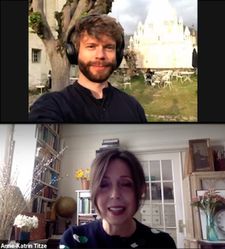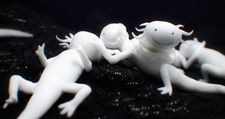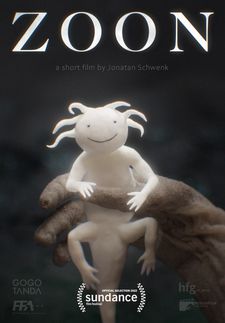![Jonatan Schwenk on Zoon: “I think the first thing that I had in mind was an approach to make a different film than my last one [Sog].”](/images/newsite/Zoon_600.jpg) |
| Jonatan Schwenk on Zoon: “I think the first thing that I had in mind was an approach to make a different film than my last one [Sog].” Photo: courtesy of Jonatan Schwenk |
Jonatan Schwenk’s Zoon (co-written with Merlin Flügel) along with Alison Kuhn’s Fluffy Tales, Florian Schmitz’s Le Pré Du Mal, Luis Schubert’s Blind Spots, Kilian Armando Friedrich’s Edgy, Lina Drevs’s Sis - Best Sister, Felix Länge’s Why We Juggle, Laurenz Otto’s Against All Odds (Allen Zweifeln Zum Trotz), and Jakob Werner’s How Such An Annoying Drizzle Can Be Silent (Wie Ein So Lästiger Regen Schweigen Kann) are in the Next Generation Short Tiger program screening at this year’s Cannes Film Festival.
 |
| Jonatan Schwenk with Anne-Katrin Titze outside the Royal Abbey of Fontevraud: “An old monastery, super old, I think built around a thousand years ago. I’m here in a writing residency for animation. |
When I spoke with Jonatan Schwenk he was in the International Residency for Animated Films program (NEF) at the Royal Abbey of Fontevraud in France. Zoom had its world premiere at Sundance and his first short Sog won the Annecy International Animated Film Festival Best Graduation Film.
In Zoon, a little white salamander coming out of the water meets another little white salamander. They exchange kisses, smile, play, eat a paw, and grow it back. Just when we think we figured out some of the rules of the game, a big hungry creature resembling a potato sack on two legs enters the picture. Is it harvest time? What do the forest creatures think? Floating and sparkling, the experiences seem timeless, when a long distant past meets perhaps the future of the Earth.
From outside the Royal Abbey of Fontevraud, Jonatan Schwenk joined me on Zoom for a in-depth conversation on Zoon and his working process.
Anne-Katrin Titze: Hello Jonatan!
Jonatan Schwenk: Hi, I hope you can hear me well, it’s a bit windy. It’s the only place I could find and there are some bells ringing right now.
AKT: I see you are on a meadow somewhere in France.
JS: I am in Fontevraud. It’s an abbey, an old monastery, super old, I think built around a thousand years ago. I’m here in a writing residency for animation.
AKT: This is for your next project you are working on?
 |
| Jonatan Schwenk on Zoon: “This time we tried puppeteering for the first time as a team.” Photo: courtesy of Jonatan Schwenk |
JS: Exactly. I’m trying to write a new short film and I share this residency with eight other animators from all over the world. It’s really a great programme.
AKT: What is the programme called?
JS: It’s called NEF. It’s the International Residency for Animated Films. In animation it’s really highly recommended.
AKT: Let’s talk about Zoon. What was the starting point for it? Was it the little white smiling creatures or the potato sack people? Or was it the philosophical idea? What came first?
JS: I think the first thing that I had in mind was an approach to make a different film than my last one. I felt that after my last film which was a super heavy, dystopian, dark, gloomy film …
AKT: Sog that is?
 |
| Jonatan Schwenk on Zoon and the axolotl: “I have the axolotl who are super happy with what they have.” Photo: courtesy of Jonatan Schwenk |
JS: Yeah, Sog. I felt I needed something light, a bit more cheerful. If you are working on something for such a long time, I felt that I needed that for myself and also for my team. So I thought: How about a film where everyone is smiling and happy? A film about bliss and joy? Basically all the things that are good in life, like food, sex, movement. Well, enjoyment.
AKT: With a little bit of cannibalism included? Well, the body parts grow back so there is some kind of resurrection as well and a floating to the light. It’s not completely bliss; bliss comes at a price, no? There’s an explosion and the ending could be read in different ways.
JS: That’s the thing! I think with that approach I kind of failed. I didn’t really manage to make this cheerful film because it never works like that. There’s always the other side of the coin. I realised I needed this ending; some would call it tragic. You have at the very ending this combustion. Now we are spoiling it - I hope people saw it before reading this.
AKT: I don’t think it is a spoiler.
 |
| Floating policeman in Bruno Dumont’s Slack Bay |
JS: Maybe the moment of combustion is also not that important. For me more important is the moment right before, when those creatures have tears in their eyes and they just enjoy the moment. They are in the moment and manage to not think things. They experience something they haven’t before; they see the sunlight.
AKT: The whole idea of the floating made me think of Bruno Dumont. I don’t know if you are familiar with the films of Bruno Dumont?
JS: I’m afraid no.
AKT: It’s not animation. He has detectives and other characters suddenly float in the air to great effect. There’s a Virgin Mary in there somewhere as well. Anyway, I was reminded of the metaphorical floating up because of a feeling. It doesn’t have to be all positive, but it does represent in a way no fear. There’s a fearlessness I liked about your film. Even at the start with the eating of body parts, there’s no fear. Were you thinking of that?
 |
| Zoon poster |
JS: Not so much. I think it was more of a moment of not being worried in a sense. To just let go. But that is also some kind of not being fearful, right? About the eating part of the axolotl themselves, they do this sometimes. Axolotl for example, they eat their fellow siblings. Also they can regrow body parts. They are amazing creatures. They have this ability to regrow parts of their body, even big parts. For me that was a symbol for what we kind of lost as a species. I’m observing these two species, I have the axolotl who are super happy with what they have. They are more modest. On the other hand we have these bipeds, who are really searching for something. They take risks and are super eager to discover new things.
AKT: Technically, you were using partly puppets and partly drawings? How did you combine the images, the visuals? It’s quite unique.
JS: I really like to combine different techniques, especially if they are handmade. This time we tried puppeteering for the first time as a team. We didn’t have any experience on that. We were more like stop-motion people mostly, but I was interested in trying out a new technique. It was an approach to also bring coincidences back in the game. Because I sometimes was frustrated that things were super controlled. I don’t know if it’s so visible anymore in the result, but if I had done the whole thing in stop-motion, it would have taken a super long time. So I ended up animating only the axolotls in stop motion and the bipeds are puppets and we basically shot them in five long days. This was maybe the playful part, at least for the team. We had a lot of postproduction to do to remove the sticks that would lead the limbs of the bipeds. I find it an interesting technique and would like to discover more.
AKT: What I like is that it could take place in the long distant past or in the future of the world, or maybe it is of the present. Is your new project similar or you don’t know yet?
 |
| 2022 Next Generation Short Tiger |
JS: First of all, I’m happy you say so, that it’s kind of timeless for you. I like the idea that it is super unclear and could happen anywhere anytime. About the new project it’s very hard to say. It’s too soon. One day I like everything and the next I’m like, hm, what is this?
AKT: I understand. A comment about the sound effects - at times it is like a dog’s squeaky toy sound the little creatures, the axolotl, make. Can you talk about how you were working on the sound design?
JS: We tried to have a similar thing as on the layer of image. The image goes from very close to super wide, from very dark to bright, from monochromatic to saturated. The sound is a similar thing, especially if you have the chance to watch it in a theatre with surround sound. It goes from the centre speaker to the full immersion range, from super low to loud, from minimalistic to more bombastic. Does this make sense?
AKT: It does make sense. The full range! Thank you! Enjoy the monastery!
JS: Thanks and thanks a lot for this chat!
The 75th edition of the Cannes Film Festival runs from Tuesday, May 17 through Sunday, May 28.





















